Attila Richard Lukacs is a Canadian-born, internationally acclaimed painter. He became famous in the 1980s with his large scale canvases of skinheads. He has an amazing, rich oeuvre with hundreds of paintings but has also lived the tormented life of a 21st century artist.
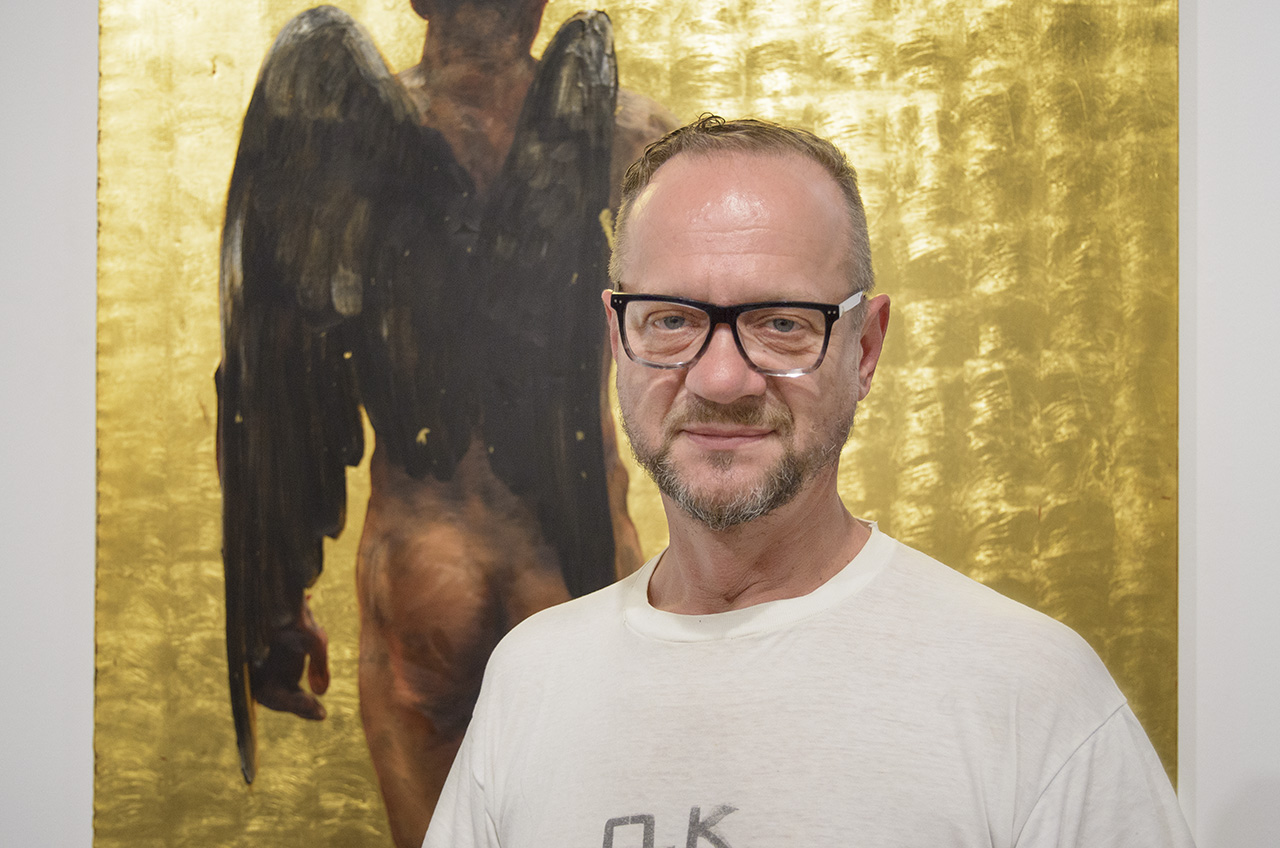 Attila Richard Lukacs, June 26, 2014, Mocca. Photo: Elena Iourtaeva
Attila Richard Lukacs, June 26, 2014, Mocca. Photo: Elena Iourtaeva
Interview with Attila Richard Lukacs (A.R.L) by Emese Krunák-Hajagos (E.K-H)
E.K-H: In the group-show, Over the Rainbow: Seduction and Identity, organized from the collection of Salah Bachir and Jacob Yerex at the Museum of Contemporary Canadian Art, your paintings stand out for their strength and painterly value. Where and when did you meet Salah Bashir and how did his collection of your work become so great?
A.R.L: I met Salah in Berlin in 1988 or 1989. Michael Morris brought him to my studio and introduced us. Salah bought his first painting 1-800-MIKE from the show that was at 49th Parallel, NYC and later at the Power Plant, Toronto. Salah acquired — throughout my career — sometimes an entire body of work, by commissioning, and through secondary market. He bought what he loved.
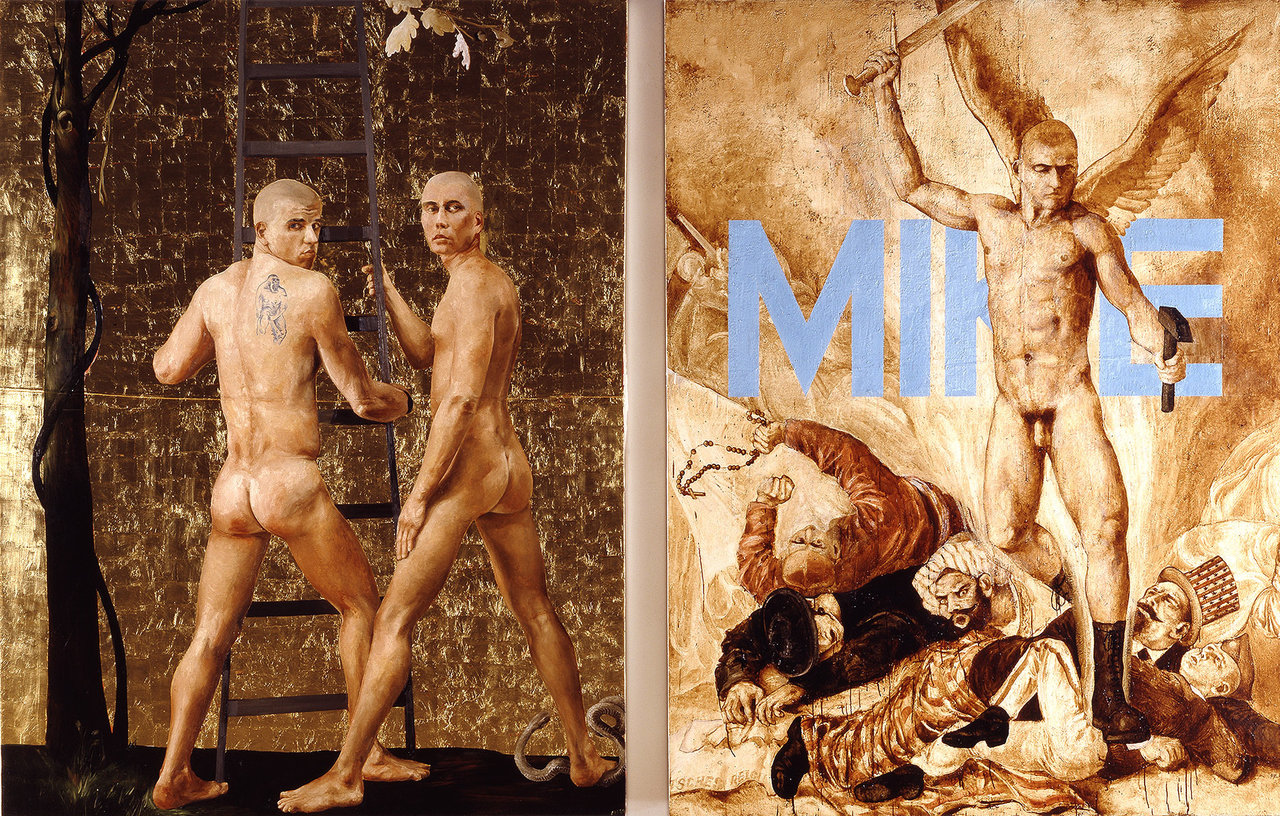 Attila Richard Lukacs, 1-800-MIKE, dyptych, 1989. Oil, gold leave and mixed media on canvas. From the Collection of Salah Bachir and Jacob Yerex.
Attila Richard Lukacs, 1-800-MIKE, dyptych, 1989. Oil, gold leave and mixed media on canvas. From the Collection of Salah Bachir and Jacob Yerex.
E.K-H: The Power Plant show in 1989 was my first exposure to your work. I found it an extremely strong, “mature” show. Tell us more about those years.
A.R.L: I started that body of work when I moved to Berlin in the fall of 1986. My friend Michael Morris helped me to get a studio in Kunstlerhaus Bethanien on Marieneplatz. I was an artist in residence there for a year and a half. I started that cycle of paintings immediately. Those paintings were exhibited in Bethanien’s Gallery that used to be a hospital chapel and they fitted that place very well. That was also the time when I started to paint the monkeys — they came into the vocabulary at the same time as the skinheads. I guess I did those painting in a year — year and a half — it was very fast. After that they came to the Power Plant.
E.K-H: Were you “at the right place at the right time” in Berlin?
A.R.L: At that time in Berlin there weren’t many galleries, it wasn’t like it is today. But it certainly was “the right place at the right time” for me. I was itching to get out of Canada and I knew there was something out there more exciting than the Calgary suburb I grew up or the hippy-like student community in Emily Carr College of Art and Design. I just wanted to move — get away from it all. Berlin was an exciting city — and it was the sexuality there too, the codified skinheads of the world. Those codes and symbols that existed there became part of my paintings like white laces, red laces, white braces, red braces, and tattoos. They became part of the paintings because they were part of the sex scene. It was understood that it was only for the weekend and the guys might hop into a taxi to get home, to not get beaten up on the U-bahn.
 Attila Richard Lukacs, Coo coo ka-choo, Mr. Robinson, 1999. From the Collection of Salah Bachir and Jacob Yerex. Photo: Toni Hafkensheid.
Attila Richard Lukacs, Coo coo ka-choo, Mr. Robinson, 1999. From the Collection of Salah Bachir and Jacob Yerex. Photo: Toni Hafkensheid.
E.K-H: I can understand why you painted those skinheads in life size. They seem to be present in the room. Did you use models for them?
A.R.L: I started to use Polaroid. It was immediate and I could see from it what I was going to paint. It was really useful since I was taking references from art history like Caravaggio, Degas or David. I posed the models according to those historical references. There were various costume changes: with boots, without boots and gradually undressing them. Micha, my boyfriend, owned a gay bar and one evening he said “I found a model for you” and I loved Alex. He was definitely my muse. The other references came from pornographic magazines I found in the bookshops of Berlin. They were dirty, very dirty, scatological, heavy on fetishes, very hard core and they were fascinating. I wasn’t directly using the paintings or the photographs but taking some part of them and collaging them into my paintings.
 Attila Richard Lukacs, After Goya, 2000, 12 polaroid prints 31 cm x 40.5 cm each. Courtesy the artist.
Attila Richard Lukacs, After Goya, 2000, 12 polaroid prints 31 cm x 40.5 cm each. Courtesy the artist.
It was a year and a half I worked on those paintings and they were big, I was working on scaffolding, and the scaffolding became part of the paintings. I also had those proscenium arch windows in my studio that are in many of my paintings as part of a stage or backdrop against which a drama is set. Caravaggio also used that arch. I still use that motif in Vancouver now. The architecture and the museums were great in Berlin and the city, the buildings, the streets, the history there and the gay history all influenced my work.
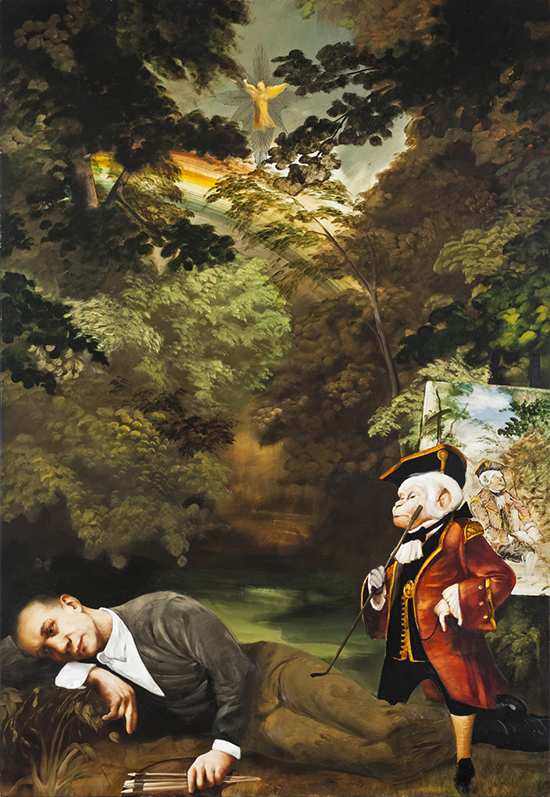 Attila Richard Lukacs, The lazy kunstler, and the well travelled monkey, 1995. Oil on canvas. From the Collection of Salah Bachir.
Attila Richard Lukacs, The lazy kunstler, and the well travelled monkey, 1995. Oil on canvas. From the Collection of Salah Bachir.
That was the birth of the techno generation in Germany and I was right there in Berlin when the love parade started. I found that world as exciting as the paintings I was doing at that time. They co-existed well. My friends were brilliant and they created a great techno empire and we became rich and were shopping at Armani and Gucci. But at some point the techno house came crashing down on us and a lot of people had to leave. Those people — the expats from Canada and my “NY sisters” — all arrived in Berlin at the same time and about 10 years later we all departed at the same time. Good things happened to us there, and they’re still my friends.
E.K-H: You moved to New York in 1996. What was your experience there?
A.R.L: I didn’t use New York as well as I should have. NY is very expensive, so I had to do what I could to survive. My overhead was very high. I had a gallery I worked with, Phyllis Kind. I did a couple of exhibitions with her and I was also showing at Diane Farris in Vancouver and here in Toronto too. I was doing a residency with the Boston Museum School of Fine Art, flying up there Friday mornings and back to NY Friday afternoons. I had so much going on but I didn’t really network that well. I think, in the end, I didn’t make all the connections I should have and my work suffered from the stress of what I had to produce, what I knew would bring revenue. Attempting to do that weakened my confidence. I still did some great work there like the Arbour Vitae series (2000). It was a total abstraction. It left the figure behind and it was really freeing. There was an expectation of painting figures, not only other’s expectations but mine too. Many of those figurative paintings that I painted with enthusiasm were not treated well because of their themes. I was not happy about the direction my painting was going and I was battling with that feeling. I painted the Garden series in 1999 and Salah Bachir bought some of them. I saw myself going further, but people were asking about the skinheads with those boots even though they were there in the Garden series. I never really persuaded that issue in a proper way.
 Attila Richard Lukacs, Arbour Vitae C, 2000. Mixed media on canvas. From the Collection of Salah Bachir.
Attila Richard Lukacs, Arbour Vitae C, 2000. Mixed media on canvas. From the Collection of Salah Bachir.
Because of that and my substance abuse I became depressed. There was no energy in my work since I didn’t have any energy to put into it. I did some good work but theoretically not every painting was a good painting. I wish I had held some back and not put out so much, but I was trying to support too many luxury habits. It all snowballed and that was the tipping point where I put my foot on the edge of the abyss and from there I was slipping down fast. I know I’ve seen hell and evil. It almost drove me mad.
Also at that time, the meat packing district in NY was getting hip, more expensive, and my studio rent was going up too much, so I had to move and I recognized that it was time to leave NY.
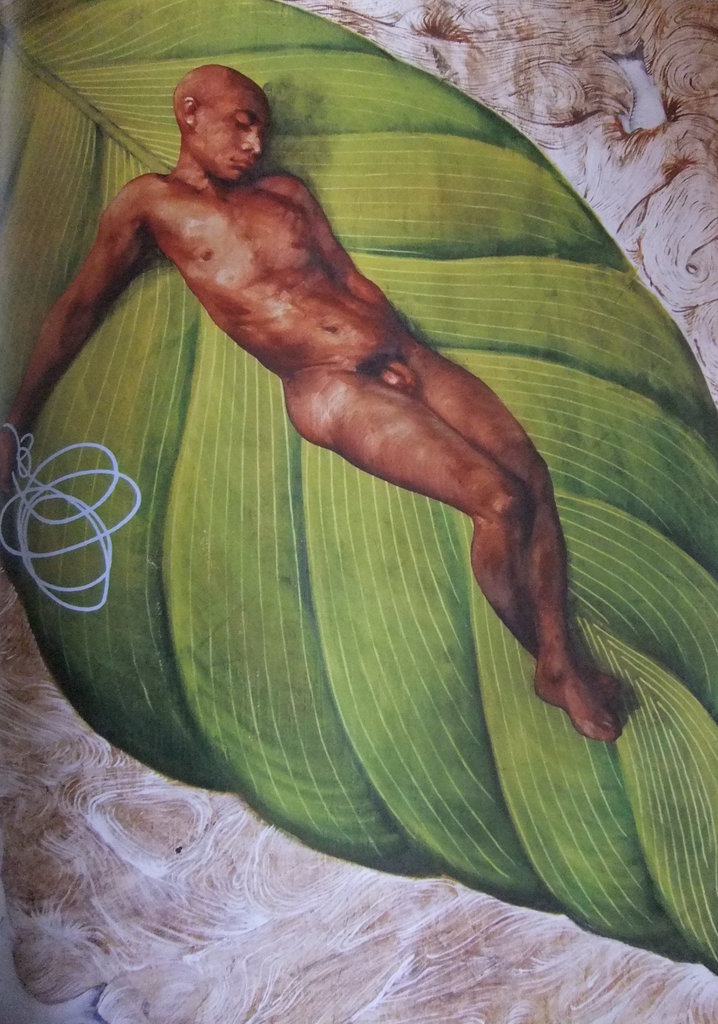 Attila Richard Lukacs, A Boy Floating on a Leaf, From the Garden series, 1999. Oil on canvas. From the Collection of Salah Bachir.
Attila Richard Lukacs, A Boy Floating on a Leaf, From the Garden series, 1999. Oil on canvas. From the Collection of Salah Bachir.
E.K-H: You’ve mentioned that in Hawaii the rain helped you to create some paintings. Did the nature there aid in your recovery?
A.R.L: I always had a love for nature, even as a child, and there were often trees, butterflies or flowers in my paintings.
I needed to go to the complete opposite of NY and that was in Maui, Hawaii. I was lucky that I could dream up that destination because of the love and support of my parents. The spirits of Maui were so much healthier and helped me to heal. There was that energy from nature that connects us all in a web. It was the total opposite of the darkness that I went through. I wasn’t even sure I had any soul left. But I grabbed it back bit by bit in Hawaii. It was lovely to listen to the wind and see the spirits.
E.K-H: Then around 2003, back in Vancouver, came an abstract period with black and white and grey. There is a Hungarian saying: further from the word – meaning getting gradually further from naming things but at the same time getting closer to the core of them. Is it true for that series or the landscapes that followed?
A.R-L: I actually think that is exactly what it was. Even those paintings in Berlin weren’t figurative when I started to paint them. They were canvases and I was just putting down backgrounds for them and amazing things happened that way. Unexpected things. Experimental chances that became a beautiful way of painting. Before those abstract paintings and grisailles around 2011, I did some large paintings. They were my reaction to the American invasion of Iraq and the propaganda that surrounded it. Those canvases were heavy with possible narratives.
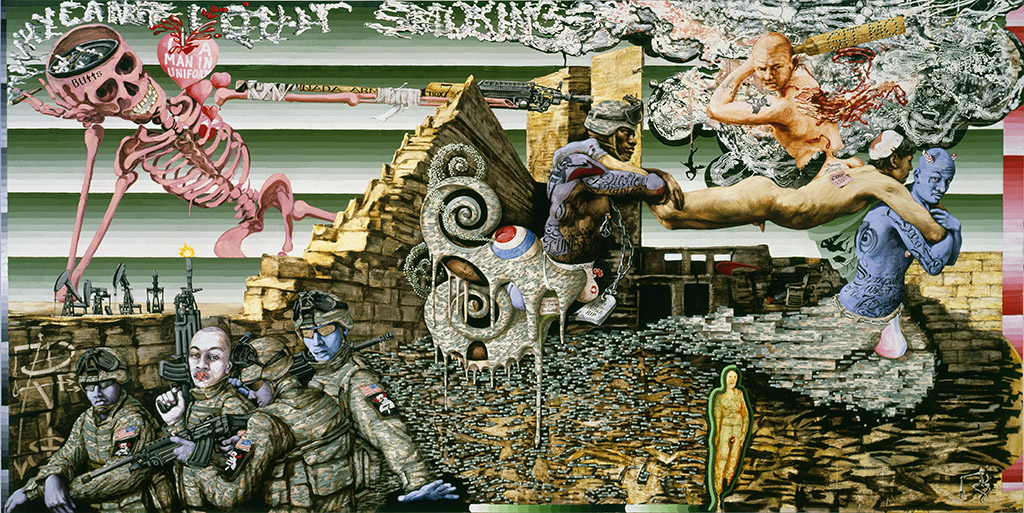 Attila Richard Lukacs, Seven Devils Dead, 2008. Oil on canvas, 80 x 162 inches. Courtesy of the artist.
Attila Richard Lukacs, Seven Devils Dead, 2008. Oil on canvas, 80 x 162 inches. Courtesy of the artist.
In those abstract works that followed them, I just focused on all kinds of gestures and movements that one makes toward creating a surface or just let the paint flow down on the canvas. It was cathartic just to paint the surface instead of working on a composition for 3-4 months. I wanted to paint a gesture or abstract without thinking about painting between the lines.
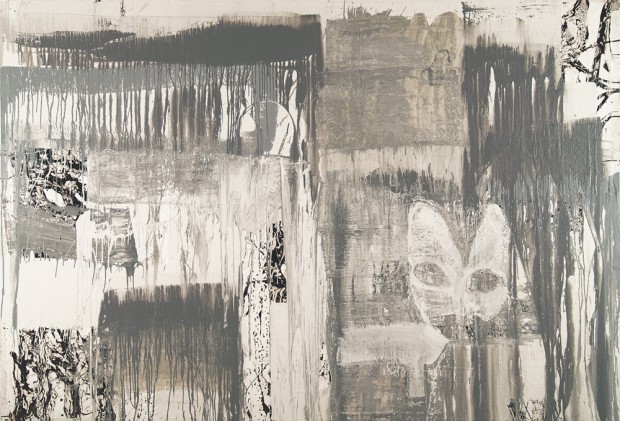 Attila Richard Lukacs, Silver Garden, 2011. Oil and enamel on canvas. From the Collection of Salah Bachir.
Attila Richard Lukacs, Silver Garden, 2011. Oil and enamel on canvas. From the Collection of Salah Bachir.
E.K-H: Do you think about bringing the figures back?
A.R.L: The figures are coming back in different ways. I still think that most of my paintings today are figurative, even when the figure is completely absent. There are also compositions where I use the figure but broken down so there’s just a hand or feet or a bum or a lotus made of ten penises. I also painted three portraits of my friend Fred and also because I wanted to do a life size etching of him.
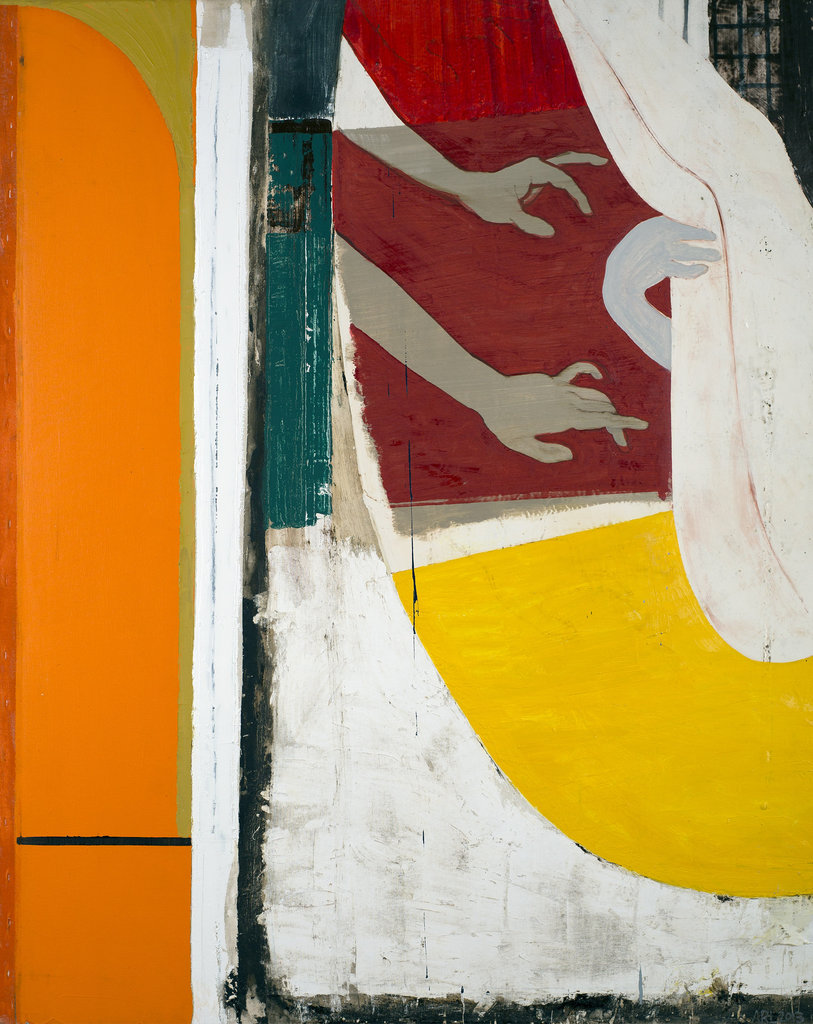 Attila Richard Lukacs, Composition with Proscenium – Cadmium Orange #1, 2013. Oil, enamel and bitumen on canvas, 60 x 48 inches. Courtesy of the artist.
Attila Richard Lukacs, Composition with Proscenium – Cadmium Orange #1, 2013. Oil, enamel and bitumen on canvas, 60 x 48 inches. Courtesy of the artist.
The landscapes are my main focus now and they come from the garden. It’s a garden of my imagination and of painting. I have always been inspired by the Indian miniature paintings. I find their use of colour and composition contemporary. It is also true to the renaissance landscapes.
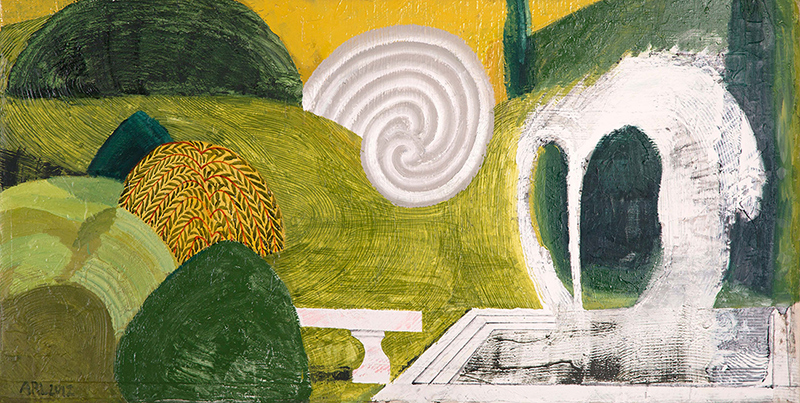 Attila Richard Lukacs, The Wind in Shahibaug, 2012. Bitumen, polyurethane, traffic paint, oil and enamel on canvas, 33.5 x 66 inches. Courtesy of the artist.
Attila Richard Lukacs, The Wind in Shahibaug, 2012. Bitumen, polyurethane, traffic paint, oil and enamel on canvas, 33.5 x 66 inches. Courtesy of the artist.
E.K-H: Do you still work a lot?
A.R.L: I work every day except Sunday. I need discipline to take Sunday off and do my chores or do nothing.
E.K-H: What are your plans? That “coffer” is always packed and waiting for you in Berlin – are you thinking about returning there?
A.R.L: I would like to go back to Berlin but I would only go for 3 or 4 years, get a studio there and do a body of work. Perhaps it would establish a back-and-forth dialogue between Vancouver and Berlin, but it will take a couple of years.
